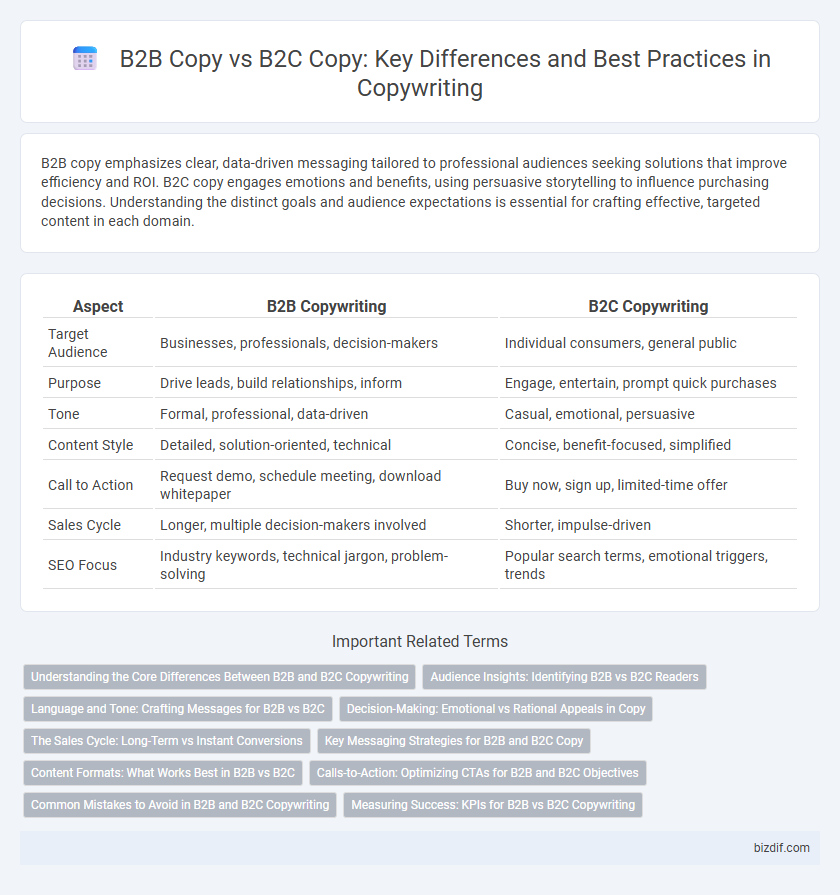B2B copy emphasizes clear, data-driven messaging tailored to professional audiences seeking solutions that improve efficiency and ROI. B2C copy engages emotions and benefits, using persuasive storytelling to influence purchasing decisions. Understanding the distinct goals and audience expectations is essential for crafting effective, targeted content in each domain.
Table of Comparison
| Aspect | B2B Copywriting | B2C Copywriting |
|---|---|---|
| Target Audience | Businesses, professionals, decision-makers | Individual consumers, general public |
| Purpose | Drive leads, build relationships, inform | Engage, entertain, prompt quick purchases |
| Tone | Formal, professional, data-driven | Casual, emotional, persuasive |
| Content Style | Detailed, solution-oriented, technical | Concise, benefit-focused, simplified |
| Call to Action | Request demo, schedule meeting, download whitepaper | Buy now, sign up, limited-time offer |
| Sales Cycle | Longer, multiple decision-makers involved | Shorter, impulse-driven |
| SEO Focus | Industry keywords, technical jargon, problem-solving | Popular search terms, emotional triggers, trends |
Understanding the Core Differences Between B2B and B2C Copywriting
B2B copywriting targets business decision-makers with a focus on logic, detailed product benefits, and ROI-driven language, emphasizing professional solutions tailored to industry-specific challenges. B2C copywriting appeals to individual consumers by leveraging emotional triggers, simplified messaging, and brand storytelling to drive immediate engagement and purchasing behavior. Recognizing these core differences ensures copywriters craft precise, effective messages that resonate with the unique motivations of each audience.
Audience Insights: Identifying B2B vs B2C Readers
B2B copywriting targets professional decision-makers who prioritize efficiency, ROI, and industry expertise, whereas B2C copy appeals to individual consumers driven by emotions, personal benefits, and brand affinity. Understanding audience insights involves analyzing job roles, pain points, buying processes, and communication preferences in B2B, contrasted with lifestyle, desires, and immediate needs in B2C. Tailoring messages with this segmentation enhances engagement and conversion rates by resonating with the specific motivations and behaviors of each group.
Language and Tone: Crafting Messages for B2B vs B2C
B2B copywriting employs formal, professional language emphasizing value, efficiency, and ROI to resonate with business decision-makers, while B2C copy leans toward conversational, emotional, and relatable tones to engage individual consumers. B2B messages prioritize clarity, trust-building, and technical details, supporting complex purchasing processes. B2C copy often uses persuasive, storytelling formats that trigger instant emotional responses and encourage immediate action.
Decision-Making: Emotional vs Rational Appeals in Copy
B2B copywriting prioritizes rational appeals by emphasizing data-driven benefits, ROI, and efficiency to align with logical decision-making processes of business buyers. B2C copy leverages emotional appeals, targeting personal desires, lifestyle aspirations, and immediate gratification to influence consumer behavior. Understanding these decision-making differences enables copywriters to tailor messages that resonate with either business stakeholders or individual consumers, enhancing engagement and conversion rates.
The Sales Cycle: Long-Term vs Instant Conversions
B2B copywriting targets longer sales cycles that require nurturing leads through detailed information, case studies, and trust-building content, as purchasing decisions often involve multiple stakeholders and higher risks. In contrast, B2C copy prioritizes instant conversions by using emotional appeal, clear calls-to-action, and concise messaging designed to trigger quick buying decisions. Understanding these sales cycle dynamics is essential for crafting content that effectively addresses the unique needs and behaviors of each audience.
Key Messaging Strategies for B2B and B2C Copy
B2B copywriting emphasizes logical appeals, highlighting ROI, efficiency, and expertise to resonate with professional decision-makers seeking value and trust. B2C copy leverages emotional triggers, focusing on lifestyle benefits, personal identity, and instant gratification to engage individual consumers' desires. Tailoring key messages to audience priorities ensures effective communication and higher conversion rates in both B2B and B2C contexts.
Content Formats: What Works Best in B2B vs B2C
B2B copywriting thrives with in-depth whitepapers, case studies, and detailed reports that address complex industry challenges and provide data-driven insights, building authority and trust among professional audiences. B2C copy emphasizes concise blog posts, engaging social media content, and compelling video formats designed to capture emotions and drive immediate consumer action. Tailoring content formats to the decision-making process and consumption habits of each audience maximizes engagement and conversion rates in both B2B and B2C contexts.
Calls-to-Action: Optimizing CTAs for B2B and B2C Objectives
Effective B2B copywriting uses CTAs that emphasize clear value propositions and problem-solving benefits tailored for decision-makers, often featuring phrases like "Request a Demo" or "Download the Whitepaper." B2C CTAs prioritize emotional triggers and immediacy, such as "Buy Now" or "Limited Time Offer," to drive quick consumer action. Optimizing CTAs requires understanding buyer intent nuances, leveraging data-driven insights to align messaging with either business goals or personal customer desires.
Common Mistakes to Avoid in B2B and B2C Copywriting
B2B copywriting often falters by overcomplicating language, making messages less accessible to busy decision-makers, while B2C copy can mistakenly rely on cliches that fail to engage consumers emotionally. Both sectors commonly overlook the importance of clear calls-to-action, which reduces conversion rates and diminishes campaign effectiveness. Ensuring tailored messaging that resonates with the specific audience's needs and pain points dramatically improves engagement and response.
Measuring Success: KPIs for B2B vs B2C Copywriting
B2B copywriting success is typically measured by lead generation, conversion rates, and sales cycle length, reflecting long-term relationship building and decision-making processes. In contrast, B2C copywriting KPIs prioritize metrics such as click-through rates, engagement levels, and immediate purchase behavior, highlighting fast consumer responses. Understanding these distinct KPIs enables marketers to tailor strategies effectively for business clients or individual consumers.
B2B Copy vs B2C Copy Infographic

 bizdif.com
bizdif.com